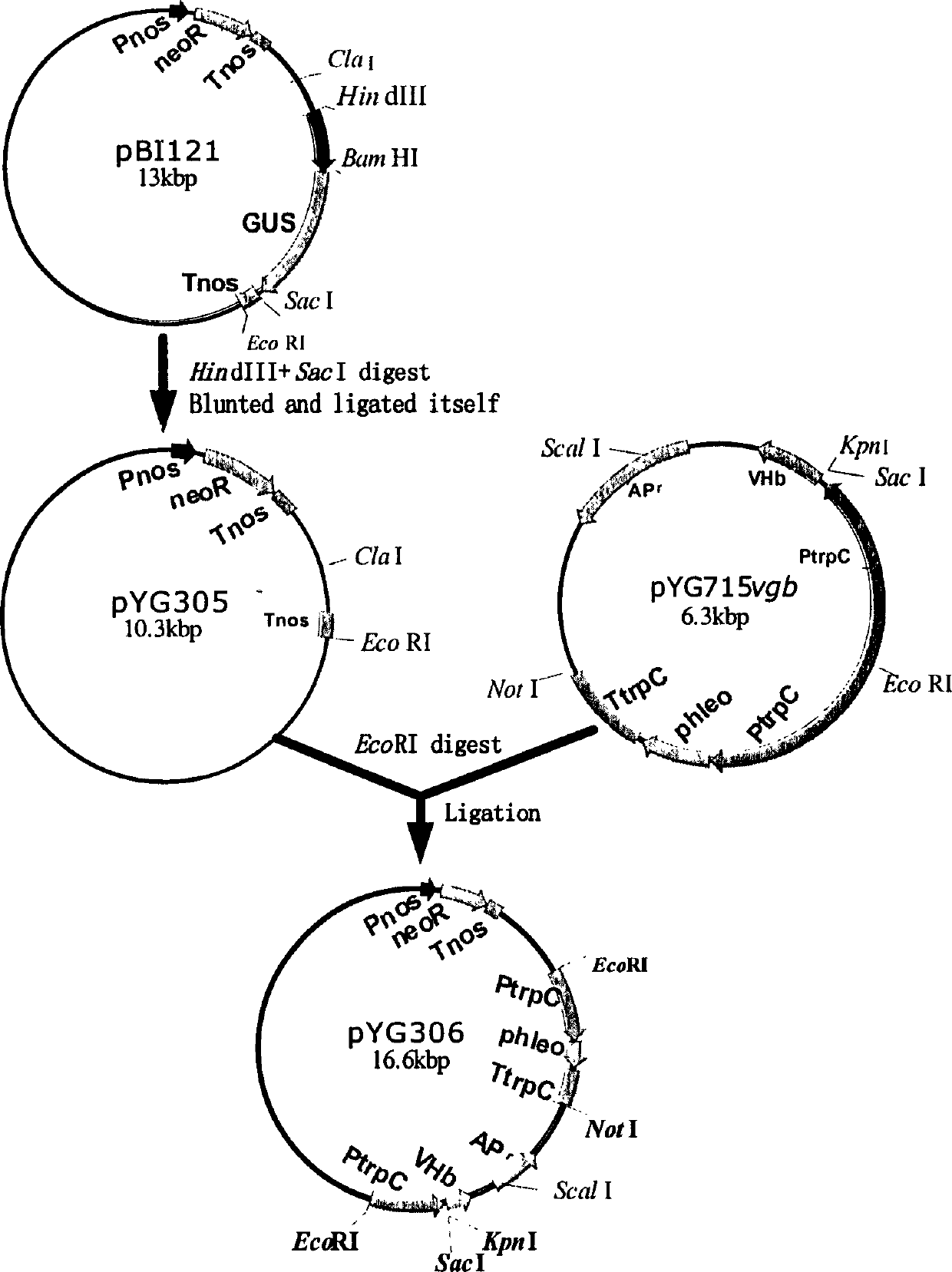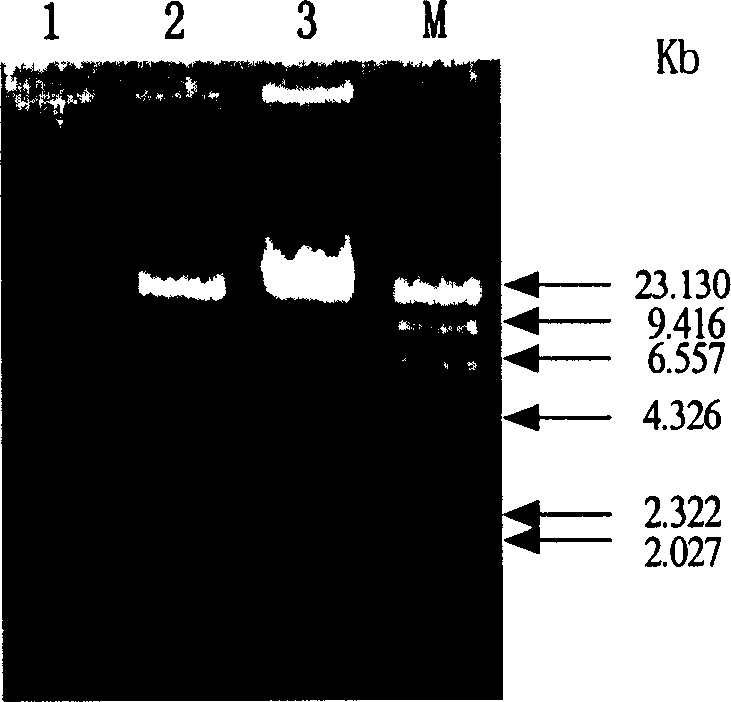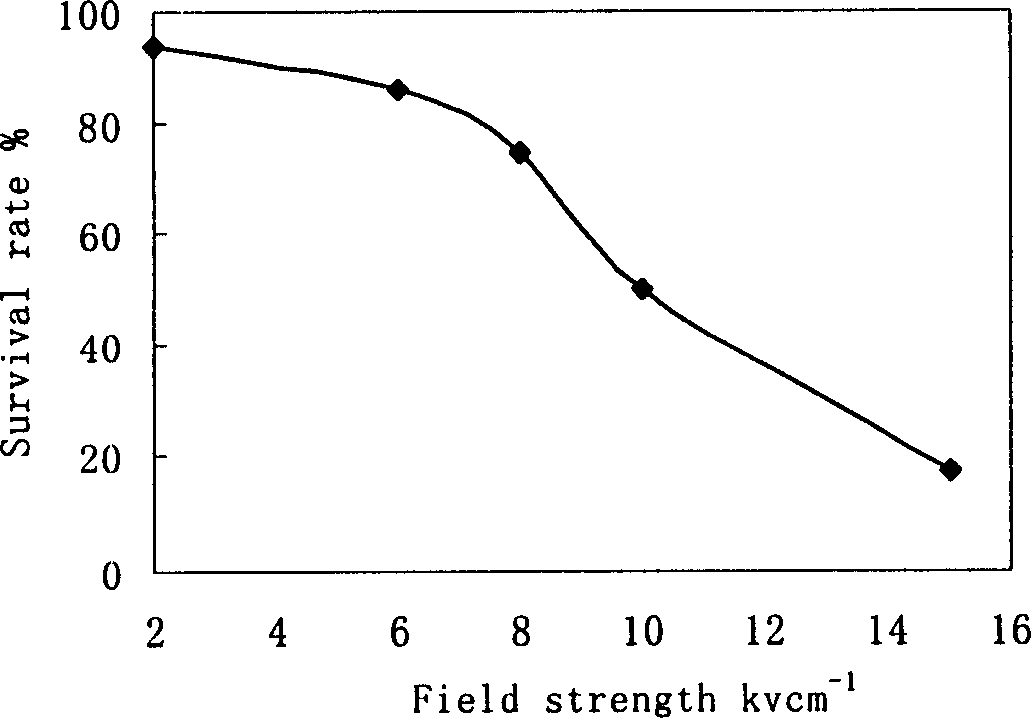Conversion for Agrobacterium tumefaciens mediated plasmid to parietal sporamycin
A technology of Agrobacterium tumefaciens and Cephalosporium acremonium, applied to bacteria, using vectors to introduce foreign genetic material, recombinant DNA technology, etc., can solve the problems of low efficiency of Cephalosporium acremonium, achieve large industrial value, improve transformation rate, and plasmid The effect of widening the range
- Summary
- Abstract
- Description
- Claims
- Application Information
AI Technical Summary
Problems solved by technology
Method used
Image
Examples
Embodiment 1
[0112] Construction of intermediate vector plasmid pYG306:
[0113] Plasmid pBI121 was double-digested with SacI and HindIII, separated by agarose gel electrophoresis, and a large fragment of 10.3 kb containing T-DNA was recovered with TheGene-clean II kit (available from Qbiogene Company), and then filled in with Klenow enzyme The 5′ end, the 3′ end was cut blunt by Mung bean nuclease, and then T 4 DNA ligase ligated to construct plasmid pYG305. There is an EcoRI single enzyme cutting point between the left and right borders of the T-DNA of pYG305. The plasmids pYG715vgb and pYG305 were respectively digested with EcoRI. After separation by agarose gel electrophoresis, the digested fragments of the two plasmids were recovered, among which the 6.3kb fragment of pYG715vgb After being dephosphorylated by CIAP alkaline phosphatase, it was ligated with the large fragment of pYG305 by T4DNA ligase to construct the intermediate vector plasmid pYG306. The flow chart of intermediate...
Embodiment 2
[0115] Enzyme digestion identification of plasmid pYG306:
[0116] The size of the intermediate vector plasmid pYG306 is 16.6kbp, the ligation product is transformed into E. coli, and Ap is screened r 、Km r 、Rif r 、Sm r The results of plasmid extraction, enzyme digestion and electrophoresis verification are shown in Figure 2.
[0117] The results of enzyme digestion showed that the size of the plasmid and the main restriction sites were correct.
Embodiment 3
[0119] Research on transformation of Agrobacterium tumefaciens by electroporation:
[0120] The intermediate vector pYG306 was transformed into Agrobacterium tumefaciens LBA4404 by electric shock transformation, and resistant transformants could be screened with 100 μg / ml Ap and 50 μg / ml Km.
[0121] Effect of electric field strength on the survival rate of Agrobacterium tumefaciens:
[0122] The electric field strength is an important parameter in electro-shock transformation, and the cell survival rate is directly related to the transformation rate. The effect of electric field strength on cell viability is shown in Figure 3. The lethality rate increases with the increase of the field strength, showing that the cell survival rate decreases with the increase of the field strength. The field strength reaches 15kv.cm -1 , the cell viability was only 17.5%.
[0123] Effect of electric field strength and electric pulse time on conversion rate:
[0124] Electric field strength ...
PUM
| Property | Measurement | Unit |
|---|---|---|
| Conversion efficiency | aaaaa | aaaaa |
Abstract
Description
Claims
Application Information
 Login to View More
Login to View More - R&D
- Intellectual Property
- Life Sciences
- Materials
- Tech Scout
- Unparalleled Data Quality
- Higher Quality Content
- 60% Fewer Hallucinations
Browse by: Latest US Patents, China's latest patents, Technical Efficacy Thesaurus, Application Domain, Technology Topic, Popular Technical Reports.
© 2025 PatSnap. All rights reserved.Legal|Privacy policy|Modern Slavery Act Transparency Statement|Sitemap|About US| Contact US: help@patsnap.com



